At this stage of James’ Tour of Disco-Era Women SF Authors, we have reached M. Certain letters are deficient in authors whose surnames begin with that particular letter. Not so M. There is an abundance of authors whose surnames begin with M. Perhaps an excess. In fact, there are more authors named Murphy than the authors I listed whose names begin with I. Efforts to address this, by providing authors with exciting new initials, perhaps involving the exclamation mark or ampersand, have thus far been greeted with something less than enthusiasm by the powers-that-be.
For readers who have just joined the tour: there are several previous instalments in this series, covering women writers published in the 1970s with last names beginning with A through F, those beginning with G, those beginning with H, those beginning with I & J, those beginning with K, and those beginning with L.
Iris Macfarlane
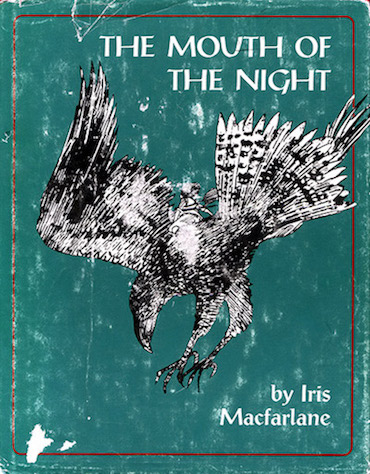
Iris Macfarlane, by all rights, should be on my List of Shame, which covers those authors I’ve somehow missed out on reading to date. A glance at her ISFDB entry reveals that my ignorance may not matter, as she seems to have had one and only one collection, 1976’s The Mouth of the Night, which makes choosing which of her works to recommend unusually straightforward. The Mouth of the Night appears to be translations from Gaelic to English of stories originally included in J. F. Campbell’s 1890 Tales of the West Highlands. I think.
Elisabeth Mace
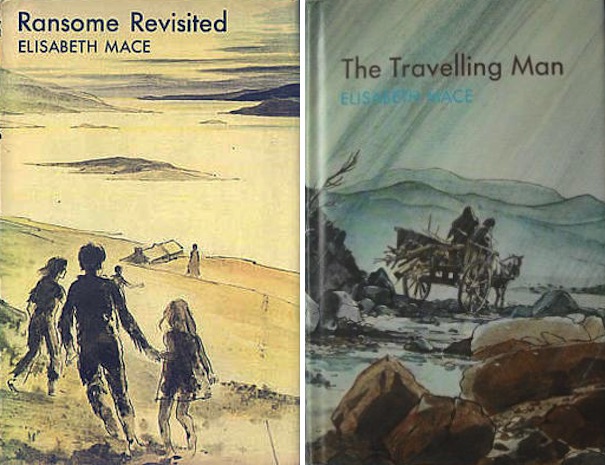
Elisabeth Mace was the author of a number of young adult novels. The logical starting point for Mace is her 1975 post-apocalyptic young adult novel Ransome Revisited, the first of two books in her Levin sequence…that is, if you can find a copy. If Mace has benefited from the recent wave of ebook reprints, I was unable to find any of hers.
Sondra Marshak

Sondra Marshak is best known for her Star Trek-related activity. Star Trek, an American science fiction television show akin to Raumpatrouille—Die phantastischen Abenteuer des Raumschiffes Orion, was cancelled after seventy-nine episodes in the mid-1960s. An anthology of original stories commissioned a decade after a show’s cancellation seems unthinkable and yet in 1976, Marshak and Myrna Culbreath’s co-edited collection, Star Trek: The New Voyages, was published by Bantam Books, soon followed by Star Trek: The New Voyages 2. This suggests that the show’s fandom managed to survive the show’s demise. Perhaps some day there will be a revival of this venerable program—perhaps even a movie!—although I must caution fans against getting their hopes up…
Fans of John Scalzi’s Redshirts may find the New Voyages story “Visit to a Weird Planet Revisited” of interest, as yet another example of science fiction authors independently hitting on very similar ideas.
Ann Maxwell
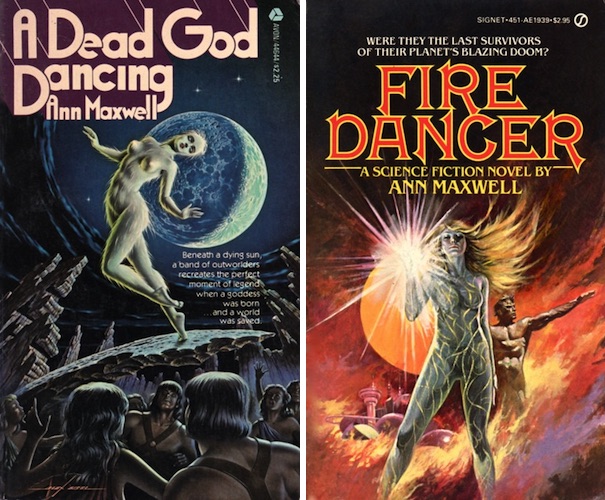
Ann Maxwell’s career might be credited to the fact that there was no internet back in the 1970s (well, no public internet; there was Arpanet for the tech elite). Isolated, without convenient sources of entertainment, and having exhausted her library’s stock of science fiction as one often did in those days, she turned to writing. Prolific and successful, her output these days is primarily in other genres, often published under the name Elizabeth Lowell. I would suggest that SF readers try her 1979’s A Dead God Dancing, a lush pre-apocalyptic novel set on a doomed world1.
Vonda N. McIntyre
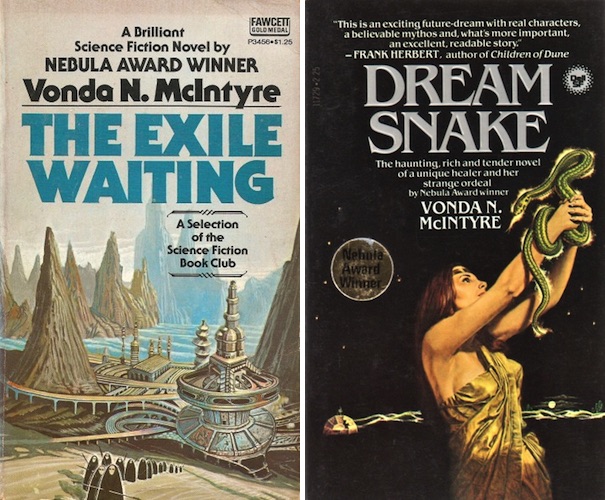
I have followed Vonda N. McIntyre’s career since I encountered her 1975 debut novel, The Exile Waiting. As have numerous other authors, she has dabbled in Star Trek novels, managing the difficult trick of seamlessly adding details to Trek plots in order to patch plot holes in the original episodes. Although my favourite work of hers is her 1979 collection Fireflood and Other Stories, it is long, long out of print. Modern readers should therefore seek out McIntyre’s Hugo- and Nebula-winning post-apocalyptic wanderjahr novel Dreamsnake, in which a wandering healer contends with blind prejudice and self-destructive family conflict.
Patricia A. McKillip
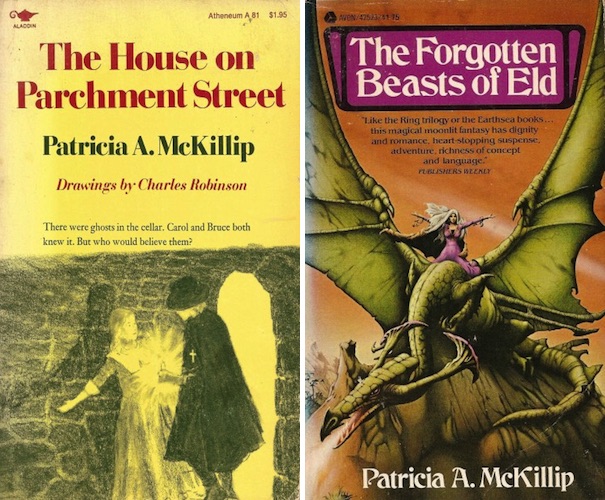
Patricia A. McKillip is an author I first encountered thanks to my inability to send back the Science Fiction Book Club forms in a timely fashion (the SFBC assumed one wanted each month’s books unless readers actively told them otherwise). So, sloth for the win! Since her 1973 debut novel The House on Parchment Street, McKillip has written over two dozen novels, garnering World Fantasy Awards, Balrog Awards, Mythopoeic Awards, the Endeavour Award, as well as too many nominations to mention. 1974’s dreamlike fairy tale The Forgotten Beasts of Eld won the following year’s World Fantasy Award, and contemporary readers can enjoy the recent Tachyon reprint.
R.M. Meluch

Although R. M. Meluch has been active since 1979’s Sovereign (whose cover looks very familiar to me, even if the plot entirely escapes me), the only works of hers I have read belong to her military SF Tour of the Merrimack series, which pits American and Romans IN SPAAACE against ravening space horrors. Not to my taste, but I know there are respected reviewers who are keen on Meluch’s works (with reservations: see here). The first Merrimack novel is 2005’s The Myriad.
Melisa C. Michaels

Although hard-nosed women action heroes were by no means unknown decades ago, neither were they especially common. Melisa C. Michaels (whose debut story, “In the Country of the Blind,” won a spot in Terry Carr’s The Best Science Fiction of the Year 9) provided one of the relatively few examples. The story belongs in the setting of her Reagan-era Skyrider series. Skyrider’s first instalment was 1985’s Skirmish, in which a talented pilot becomes a pawn in a game whose end phase may be interplanetary war.
Judith Moffett

Judith Moffett’s 1979 poetry collection Keeping Time may not be genre, depending on who you believe. Wikipedia seems convinced it is not, but ISFDB seems to think it is. That’s enough, IMHO, to warrant including Moffett now (and not in a hypothetical/possible 1980s-focused sequel to this series). Moffett’s 1987 Pennterra presents an alien world settled first by Quakers (who found a way to conform to the native Hrossa’s demands) and later by non-Quakers (who opted for a more confrontational and markedly less successful strategy.) Readers familiar with fellow Quaker Joan Slonczewski’s 1980 Still Forms on Foxfield may notice similarities. Both books feature established Quaker settlers and their alien friends contending with uncooperative Terran latecomers. Moffett, however, takes her novel in a very, very different direction than does Slonczewski.
Janet Morris
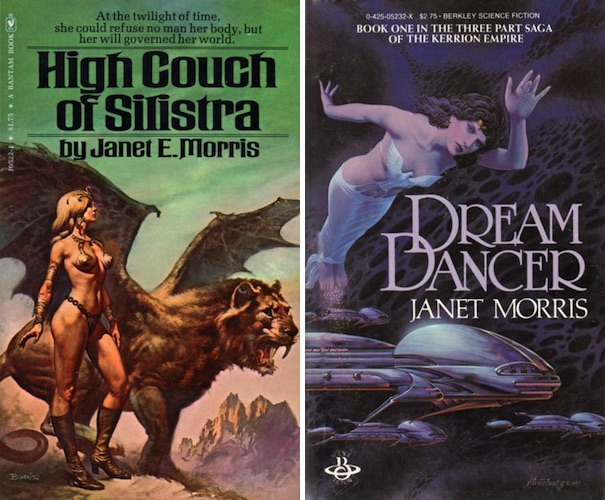
Readers familiar with Janet Morris’ work may have first encountered it in the 1980s, in that period when Morris was one of Jim Baen’s go-to authors. Morris has published thirty-three novels, fourteen anthologies, and sixty short stories of which I am aware. Of those, twenty-two novels, eight anthologies, and thirty-eight short stories appeared in the 1980s, most of them from Baen Books. I first became aware of her in the 1970s because her BDSM-flavoured planetary adventure novel The High Couch of Silistra. was very well distributed, at least in Canada. Not my thing, again, but your mileage may vary.
Jill Murphy
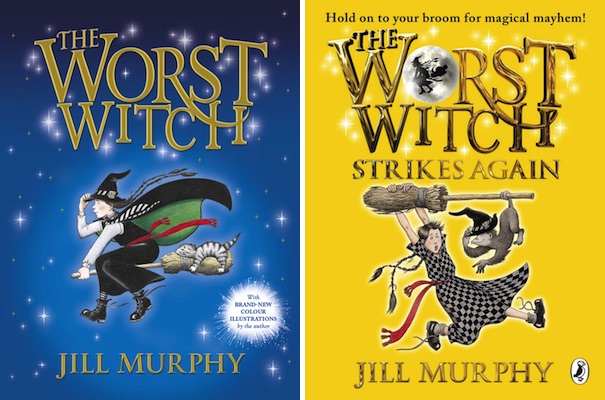
Jill Murphy’s career was very nearly done in before it began, thanks to publishers’ trepidation about the idea of trying to sell children’s stories set at a school for youthful magic users2. Nevertheless, she persisted; the result was Murphy’s popular Worst Witch series, whose first book is the eponymous Worst Witch. Tor.com readers may be too old for Murphy’s work, but their children may not be. Or, sigh, their grandchildren. Who came up with this inexorable passage of time thing?
Pat Murphy
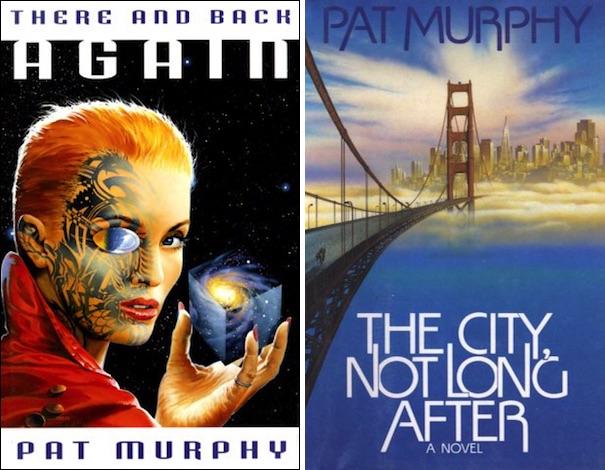
As established elsewhere, my favourite James Tiptree, Jr. Award co-founder Pat Murphy’s work is 1999’s There And Back Again, an SFnal reimaging of a certain tale of a reluctant burglar and his diminutive companions. For various reasons, There And Back Again is hard to find. In contrast, Murphy’s 1989 hopeful post-apocalyptic The City Not Long After, which pits a self-aggrandizing warlord bent on conquest against a seemingly defenceless artists’ colony in the ruins of San Francisco, is available from Open Road Media.
* * *
As one might expect from an initial shared by so many authors, this instalment’s List of Shame, those authors I have inexplicably not encountered sufficiently to comment on them, is long. Very long. Excessively long. My apologies to the authors in question. If readers have suggestions where to begin with the following, please feel free to provide them…
- Phillipa C. Maddern
- Sara Maitland
- Joyce Marsh
- Marcia Martin (looking at her ISFDB entry suggests that I have read her fiction and simply forgotten it during the ensuing decades. I’ve made a note to track down something by her. My apologies to the author: it’s nothing personal, just MCI.)
- Gloria Maxson
- Pat McIntosh
- Clare McNally
- Beth Meacham is of course well known to me as a skilled and highly regarded editor. It happens I have not read (or even ever seen) her novel Nightshade, Book One: Terror, Inc. I’ve even owned her Terry’s Universe for years, but I’ve not yet read it. Still, for readers who may not have read her fiction or anthologies, the odds are extremely good they’ve read fiction in print due to her efforts.
- Marlys Millhiser
- Cynthia Morgan
- Rita Morris
- Shirley Rousseau Murphy
1: Which I plan to reread and review as soon as I remember where I filed my copy. Not under M, apparently.
2: I know J. K. Rowling ran into publisher skepticism about the commercial viability of her Hogwarts stories, which appear to have subsequently enjoyed a degree of success. Le Guin’s 1968 A Wizard of Earthsea also focused on a Boy Who Survived and later went to a sorcerer’s school. Did Le Guin suffer the same pushback that Murphy and Rowling experienced?
In the words of Wikipedia editor TexasAndroid, prolific book reviewer and perennial Darwin Award nominee James Davis Nicoll is of “questionable notability.” His work has appeared in Publishers Weekly and Romantic Times as well as on his own websites, James Nicoll Reviewsand Young People Read Old SFF (where he is assisted by editor Karen Lofstrom and web person Adrienne L. Travis). He is surprisingly flammable.










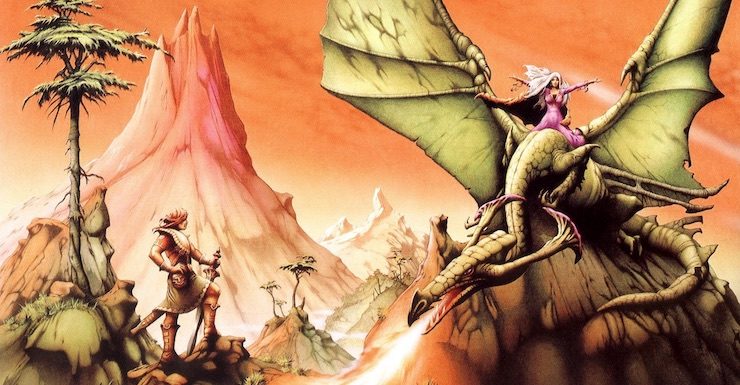
Are we counting Anne McCaffrey as an author of the 60s?
I don’t know if I actually read those Star Trek: The New Voyages collections, but I vividly remember (and really adore) the cover art from those, and from all of the James Blish episode novelizations (that being my chief exposure to the show back in the 70s — it wasn’t being syndicated on any of the stations we got in my hometown).
I’d totally forgotten about the Worst Witch series. Those were such fun!
Should check them out, with my kids, again.
Walker @1
If Wikipedia is correct, McCaffrey was first published in the 50’s…
I think I was about 12, in 1977, when a librarian recommended “The Forgotten Beasts of Eld” I don’t think she’d actually read it, she just knew it was a highly rated genre book. I liked it enough to reread it, and it was certainly memorable. I read ST:TNV around that time too, but I bought that one and reread it until it wore out.
Marshak and Culbreath wrote a number of Star Trek novels in addition to editing those anthologies. The ones I read were not at all to my taste but I expect they have fans
I suupose I got my start in scifi/fantasy reading SW comics and Oz books, but my first regular scifi novels were Anne McCaffery’s Dragonharper trilogy.
Nightshade, the Beth Meacham novel from your “List of Shame,” was the fourth entry in Byron Preiss’s Weird Heroes pulp project and was written with Meacham’s husband, Tappan King..
Back in the day, my SFF-loving brother and I agreed that having a “Mc” in one’s name apparently greatly boosted your chances of writing great SFF: Patricia McKillip, Vonda McIntyre, Anne McCaffrey, Robin McKinley and, of course, Lois McMaster Bujold!
Ursula Le Guin said that McIntyre’s Dreamsnake was a favorite of hers, which she often re-read. You can see the influence in Tehanu. For McIntyre’s Fireflood and Other Stories, people might want to try their local library. My library system has a copy. Not all who are OP are lost!
One of the best things about the Worst Witch series is the terrific illustrations, by Jill Murphy herself.
Oh, and I loved Pennterra.
There are more authors I have read in this “M” list than in any other you have posted so far in this series. Because of alphabetical order, their books must have ended up at eye level on the shelves in the bookstore!
Having a name that puts one’s books at eye level is as good as having one that places one’s books next to best sellers. And M authors get both!
Thanks for the reminder about Judith Moffett. I’d forgotten how much I enjoyed her stories. I went and checked and found that six of her books are available on Kobo. So I bought them all!
I bought three. I find Kobo’s search engine annoying.
I first read Janet Morris in the Thieves World anthologies; and went back and picked up her work before and after. One of many good habits I picked up in Sanctuary.
Do book clubs still have the same business model? I quit all such clubs more than a decade ago. Got tired of sending back those damn cards and occasionally books I didn’t want. When they asked why I’m dropping them, they said they had a program to order just what you want. Well, if that was an option, why wasn’t it offered upfront?
Shirley Rousseau Murphy’s Catsworld (or portal) fantasies are best avoided (imo).
Ah, but I see ISFDB is claiming the Joe Gray msteries as ours, and they are delightful. Have a look, starting at Joe Gray #2:
https://www.goodreads.com/series/52670
Talking-cat novels, set in a fantasy Carmel, Calif. Should be up your alley, James. I have reviews posted for many of them.
Ah. Judith Moffett! I remember “Tiny Tango” quite fondly.
Sunspear, a lot of those clubs were run by the same company, at least by the time I accidentally talked my way into freelancing for the SFBC.
I’m not sure precisely what action is intended on the cover of “Pennterra” but I am reminded that one way or another, I really need to cut the lawn.
“The Worst Witch” has been adapted as two distinct sets of television serials; BBC is currently showing theirs in Britain.
I think the only Moffet I’ve read are ‘The Ragged World’ and ‘Time Like an Ever-rolling Stream’, and have always meant to go back and re-read them because I remember very little beyond ‘hey I enjoyed those’.
Thank you for reminding me about Skyrider! I’ve been trying to find/remember that book for ages because, if I recall correctly, there is a gene for weightlessness that one of the characters (a young boy) doesn’t carry and which causes lots of problems?? I hope this is it. Now to find a copy…
Jake@19,
There’s a third book beyond those two
I’m going to put in a plug for Julian May. She wrote some SF in the 50s, then wrote a lot of non-fiction (including a Roman Catholic catechism), and returned to science fantasy in the 70s with her ‘Pliocene Exile’ novels.
If you like the intersection of Irish myth, ancient alien stuff, and powerful psychic abilities, you really need to read these novels.
According to LeGuin’s Language of the Night, her Earthsea series was commissioned by a publisher who liked her science fiction and wanted her to try writing for children.
@14: SFBC had dropped that model by the last time I was a member (~15 years ago). By then all correspondence was electronic, so “sending back the card” would have been easier, but dropping the requirement (especially when they were up to ~10 selections-of-the-month) was definitely a Good Thing.
@22: ISFDB says that the first Galactic Milieu book came out in 1981. (Side note: they’re clearly set in an alternate universe in which Boskone (SF convention, not empire) remained a dominant force instead of being imploded by attendee misbehavior; Intervention has a brief scene in their giant underground dealers’ room (which happened in 1986-7) in ~1992.)
It looks like Ransom Revisted was published as Out There in the US. I must track down these books!
I recently inherited (from a neighbor who’s fleeing East Coast winters back to California) a pile of early Trek written works, including the two New Voyages volumes pictured above, the two Best of Trek, everything else co-written by Culbreath and Marshak (*), the Blish and Foster Star Trek #N novelizations of TOS and Star Trek Log #N novelizations of TAS (but I already had those), and most of the original novels from the Bantam, Pocket Timescape, and Pocket eras. There’s a large fraction of that pile of which I was not aware, because my local library didn’t have them in the early ’90s. (A lot of exclamation points and “World” in the titles.)
I’m thinking of doing a retro-review blog series, with special attention to how different writers conceptualized the parts of the milieu that went undefined by TOS, TAS and TMP — future history of Earth, the political structure of the Federation, the cultures of Klingons and Romulans, whether adversaries other than Klingons and Romulans exist because the galaxy shouldn’t be a perfect parallel to Cold War Earth <pet peeve>.
(*) And Sherman and Shwartz, a different and non-overlapping pair of female collaborators. Huh. I think I’m conflating the writing styles of the two pairs under “not to everyone’s taste”.
Kate@25,
I agree- particularly since I am an Arthur Ransome fan!
@20, You got the right series. Melacha’s co-pilot and partner is a freefall mutant who can’t take gravity for any length of time without drugs and isn’t comfortable then. His son on the other hand can’t handle free fall at all. A subplot is trying to find drugs that will do for him what others do for his father.
A couple of authors I don’t see on the list who were both first published in the 70s, and whose names start with M:
Margaret Mahy was a New Zealand writer of YA fantasy who first published in 1971. Her book the Changeover was a favorite of mine way back when.
Robin McKinley also first published in the 70s with Beauty. She has so many very good books I’d recommend reading any.
If the author’s opinion means anything–and I would agree that sometimes it doesn’t–my 1976 (not ’79) poetry collection Keeping Time, from LSU Press, isn’t genre in any sense at all. My first genre story, “Surviving,” published in F&SF in 1986, was the first genre anything I ever wrote. So I would group myself with the 80s writers instead of the ’70s ones; but I’m so pleased to be included in this survey that I don’t really care where I’m placed–the above is just for information, in case anybody cares.
Thanks to Andy Love for remembering “Tiny Tango” fondly, to Alan Robson and James Davis Nicoll for buying so many books on Kobo, and to Saavik for loving Pennterra! Thanks also to “Jake,” for enjoying The Ragged World and Time, Like an Ever-Rolling Stream. Ragged and TimeStream are Vols. I and II of my Holy Ground Trilogy; Vol. III, The Bird Shaman, came out in 2015. All 3 are available as ebooks now, thanks to SF Gateway. And finally, to Robert Carnegie, that weed-eater thing on the cover of Pennterra has no countrpart in the story, nor does the wielder thereof.
@26/Phillip Thorne: Please do. And tell us where your blog is!
Regarding R.M. Meluch, I’d also recommend her novel CHICAGO RED. Published in 1990, it’s set in a USA a few hundred years after an eco-catastrophe resulted in sea-level rise inundating about 25% of North America (e.g., New England is now an island), and is possibly the earliest novel to depict global warming on that scale. Technology has degraded to about the early-1900’s level, and the US is now ruled by a monarchy, with a political culture like that of 18th century Europe.
I’ve seen some comments asking why Anne McCaffrey is not on the list for M (for which I silently cheer as she is my favorite author of all time). Her novels were first published in the 60’s. This includes both Restoree and Dragonflight. She did also have a few short stories published in the 50’s. As a result, she does not qualify under the original premise of this series of posts (women first published in the 70’s).
Another trivia bit, Anne McCaffrey was the first woman to win a Hugo award (Best Novella) in 1968.
I will now have to go back and read some Anne McCaffrey again :)
32: Both Syd Logsdon’s 1981 A Fond Farewell to Dying and Edgar Pangborn’s 1964 Davy feature inundated worlds. In both cases, sea level rise was preceded by a nuclear war (triggers unclear so who knows, maybe the Big Melt began before the wars). In the case of A Fond Farewell to Dying, the author didn’t settle for just melting the ice caps; he dropped a good chunk of the western seaboard into the ocean [1]. As far as I can tell, no major geological calamities in Davy but New England was an island and society had regressed to the point trousers were a lost technology.
1: Good news for Otisville!
@34: Richard Kowper’s The Road to Corlay (1978) also takes place in a flooded world — although his setting is the UK, not the US, and there is no explanation for the flood. (And for symmetry: IIRC at least one of DWJones’s books (Conrad’s Fate?) takes place in a thread where the ocean never rose high enough to separate Britain from the rest of Europe, although the climate seems too temperate for this.)
C. L. Moore should maybe be on this list?
No, because while she qualifies re: initial, her debut was well before 1970. This series is for women who debuted in the 1970s.
I absolutely *adore* Ann Maxwell’s Fire Dancer series… Now I want to go back and read them…
Wasn’t _The Worst Witch_ series adapted by HBO on a relatively low budget as a series? I recall thinkning about how it is echoed by the Harry Potter mythos, which came later.
The author of one of my favorite series, Damiano and its sequels, also doesn’t qualify: she was first published in the 1980s.
I will also stand by my contention that the women who were published in sf/f, at least through the mid-1990s, were, on average, better writers than the men. Some of these women, had they been possessors of the one x and one y chromosome would have been widely feted to this day, instead of buried in obscurity.
39: wikipedia says there was an ITV movie, a Canadian-British TV series (also ITV, I think) and a BBC adaptation.
@33, you wrote, “Anne McCaffrey was the first woman to win a Hugo award (Best Novella) in 1968.” The writing is unclear whether you are claiming Anne McCaffrey was the first woman to win for Novella in particular, or was the first woman to win a Hugo in general. The Novella Hugo was first awarded in 1968, so no one of any gender could’ve won it before then. As for the Hugo award in general, other women definitely won them before then. For example, Juanita Coulson won the Hugo for Best Fanzine in 1965.
Pat Murphy is terrific. There are 2 enjoyable “Max Merriwell” novels that follow There and Back Again.
I want to add a few dozen more “favorites” for Vonda McIntyre, who no longer seems to be actively writing. If enough of us beg, do you think she may come back?
Great series of articles! Since my “Best of Judith Merril’ book has a very 1970s cover (it was published in 1976), I had somehow expected her to be on this list. I had to google her to discover how long ago she had written “Daughters of Earth”, one of my favorite short stories.
I think I would have enjoyed the Worst Witch books more if I had discovered them in childhood — I did not find them to be the type of children’s books that adults can read easily (unlike Harry Potter. Although, in all fairness, I am not sure if HP is really a children’s series). However, I always loved the 1986 movie with Fairuza Baulk and Charlotte Rae. Sadly the new BBC series is just not as much fun.
thanks so much for this series. It’s great not only to be reminded of old favorites but to return to some of their other works.
Add me to the M-lovers. McKillip I found late but liked ver much, Vonda McIntyre remains a favorite (nut just Dreamsnake but especially The Snow Queen, both for itself and as a riff on the Andersen story, which is one of my favorites of all time).
@20
my first Melisa Michaels’ Skyrider was a used copy (25p) published by UK Women’s Press’ kids imprint. Thrilled to find there are more. Now to get copies of those. Good luck in your search!
The series I’d recommend for Shirley Rousseau Murphy would be her YA fantasy Dragonbards trilogy. Something about them just made them impossible for me to put down as a teenager.
How did I miss this entry?!? It has two of my favorites, Vonda McIntyre (Dreamsnake remains one of my top 3 books), and Ann Maxwell. I am sad her Fire Dancer series will never be finished, but Timeshadow Rider is a gorgeous sci/fi romance, and one I reread every few years.